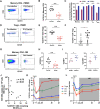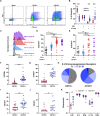The role of CD101-expressing CD4 T cells in HIV/SIV pathogenesis and persistence
- PMID: 35867722
- PMCID: PMC9348691
- DOI: 10.1371/journal.ppat.1010723
The role of CD101-expressing CD4 T cells in HIV/SIV pathogenesis and persistence
Abstract
Despite the advent of effective antiretroviral therapy (ART), human immunodeficiency virus (HIV) continues to pose major challenges, with extensive pathogenesis during acute and chronic infection prior to ART initiation and continued persistence in a reservoir of infected CD4 T cells during long-term ART. CD101 has recently been characterized to play an important role in CD4 Treg potency. Using the simian immunodeficiency virus (SIV) model of HIV infection in rhesus macaques, we characterized the role and kinetics of CD101+ CD4 T cells in longitudinal SIV infection. Phenotypic analyses and single-cell RNAseq profiling revealed that CD101 marked CD4 Tregs with high immunosuppressive potential, distinct from CD101- Tregs, and these cells also were ideal target cells for HIV/SIV infection, with higher expression of CCR5 and α4β7 in the gut mucosa. Notably, during acute SIV infection, CD101+ CD4 T cells were preferentially depleted across all CD4 subsets when compared with their CD101- counterpart, with a pronounced reduction within the Treg compartment, as well as significant depletion in mucosal tissue. Depletion of CD101+ CD4 was associated with increased viral burden in plasma and gut and elevated levels of inflammatory cytokines. While restored during long-term ART, the reconstituted CD101+ CD4 T cells display a phenotypic profile with high expression of inhibitory receptors (including PD-1 and CTLA-4), immunsuppressive cytokine production, and high levels of Ki-67, consistent with potential for homeostatic proliferation. Both the depletion of CD101+ cells and phenotypic profile of these cells found in the SIV model were confirmed in people with HIV on ART. Overall, these data suggest an important role for CD101-expressing CD4 T cells at all stages of HIV/SIV infection and a potential rationale for targeting CD101 to limit HIV pathogenesis and persistence, particularly at mucosal sites.
Conflict of interest statement
The authors have declared that no competing interests exist
Figures




References
-
- Antiretroviral Therapy Cohort C. Life expectancy of individuals on combination antiretroviral therapy in high-income countries: a collaborative analysis of 14 cohort studies. Lancet. 2008;372(9635):293–9. Epub 2008/07/29. doi: 10.1016/S0140-6736(08)61113-7 ; PubMed Central PMCID: PMC3130543. - DOI - PMC - PubMed
-
- Hiener B, Horsburgh BA, Eden JS, Barton K, Schlub TE, Lee E, et al.. Identification of Genetically Intact HIV-1 Proviruses in Specific CD4(+) T Cells from Effectively Treated Participants. Cell Rep. 2017;21(3):813–22. doi: 10.1016/j.celrep.2017.09.081 ; PubMed Central PMCID: PMC5960642. - DOI - PMC - PubMed
Publication types
MeSH terms
Grants and funding
LinkOut - more resources
Full Text Sources
Medical
Research Materials

